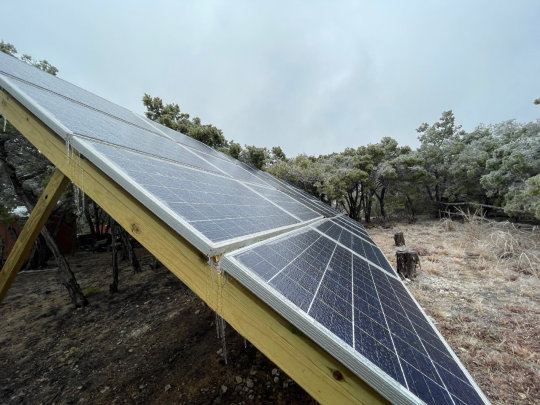#kilowatt
Explore tagged Tumblr posts
Text

commission for @scaledecho :]
#this one was very fun to work on i wont lie#oc art#my oc#friend's oc#my art#commissions#jophiel#kilowatt
9 notes
·
View notes
Text

“Don’t ask”
Kevin Maguire
#Titans#Changeling#Troia#Terra 2#Phantasm#Pantha#Nightwing#Starfire#Red Star#Cyborg#Red Wing#Kilowatt#Team Titans#Mirage#Nightrider#Kevin Maguire
28 notes
·
View notes
Text
Second time catching Sob Stories overall, and while my no-name lav mics don't make it easy to tell, they were going in all guns blazing and turned in a great performance. You can find better on YouTube if you search there... And the band members are super chill.
0 notes
Text
Watts, kilowatts and Megawatts, & simple way to convert them - Sunny Energy

This Blog was Originally Published at:
Watts, kilowatts and Megawatts, & simple way to convert them — Sunny Energy
Harnessing the power of the sun through solar panels has become an increasingly popular choice for environmentally conscious homeowners. Before diving into the world of solar energy, it’s essential to understand the terms that form the foundation of solar power systems: Watts, kilowatts and megawatts. In the end we will also discuss how a solar installer and leading Arizona solar company like Sunny energy can help you in going solar.
Understanding of terms Watts, kilowatts and megawatts
1. Watts (W):
A Watt is the fundamental unit of power in the International System of Units (SI). It is equivalent to one joule of energy per second. Watts measure the rate at which energy is generated or consumed. In the context of electricity, a 60-watt light bulb, for example, consumes 60 watts of power in one second.
2. Kilowatts (kW):
Kilowatts are a larger unit of power, where 1 kilowatt is equal to 1,000 watts. As electricity production often involves larger quantities of power, kilowatts are commonly used to express the capacity of appliances, electrical systems, and, importantly, solar panels. For example, a solar panel with a capacity of 300 watts is equivalent to 0.3 kilowatts.
3. Megawatts (MW):
Megawatts are an even larger unit of power, where 1 megawatt is equal to 1,000 kilowatts or 1,000,000 watts. Megawatts are frequently used to measure the capacity of power plants, large-scale industrial facilities, and substantial electricity grids. Solar power plants and wind farms, for instance, often generate electricity in the megawatt range.
Why are kilowatts and megawatts crucial when assessing the capacity and efficiency of solar panels?
Capacity assessment:
The capacity of solar panels is a critical factor in determining the performance through kilowatts and megawatts. It is measured in kilowatts peak (kWp), indicating the maximum power the solar panel can generate under optimal conditions. Knowing the capacity in kilowatts helps individuals and organizations estimate the potential energy output of their solar installations.
Efficiency evaluation:
Solar panel efficiency is a measure of how well the panels convert sunlight into electricity through kilowatts and megawatts. It is expressed as a percentage. Higher efficiency panels can generate more power per unit of area (such as square meters) in the same amount of sunlight. Understanding the power output in watts or kilowatts allows consumers to choose panels that align with their energy needs and available space.
Watts, kilowatts and megawatts provide a standardized and scalable way to quantify power, making them essential units of measurement when evaluating the capacity, efficiency, and performance of solar panels and other electrical systems. This understanding is crucial for making informed decisions when planning, installing, and maintaining solar power solutions.
Solar panel production in kilowatts
When it comes to solar panels, their output is measured in kilowatts. The power rating of a solar panel is typically expressed in kilowatts peak (kWp), representing the maximum power the panel can generate under Standard Test Conditions. For example, a 300W solar panel can produce 300 Watts of electricity in ideal sunlight conditions.
Solar Energy Production and Storage: Kilowatt-Hours (kWh)
Understanding energy production and storage is essential for homeowners considering solar power. The term kilowatt-hour (kWh) is a key metric in this regard, representing the amount of energy produced or consumed over time. Here’s a closer look at how kilowatt-hours are crucial in the context of solar energy:
1. Kilowatt-Hours (kWh):
A kilowatt-hour is a measure of energy equivalent to one kilowatt (1,000 watts) of power used or generated over one hour. This unit is commonly used to quantify electricity consumption in households and the output of solar energy systems. For instance, if a 1-kilowatt solar panel system operates at full capacity for one hour, it will generate 1 kWh of electricity.
2. Energy production:
Solar panels generate electricity throughout the day, with the amount of energy produced depending on factors such as sunlight intensity, panel orientation, and weather conditions. The total energy production of a solar panel system over a day, month, or year is often expressed in kilowatt-hours. Understanding kWh production helps homeowners estimate the contribution of solar power to their overall energy needs.
3. Energy storage:
To maximize the benefits of solar energy, many homeowners pair their solar panel systems with energy storage solutions, such as solar batteries. These batteries store excess energy generated during peak sunlight hours for use during periods of low sunlight or at night. The capacity of solar batteries is typically measured in kilowatt-hours, indicating how much energy they can store and supply when needed. For example, a battery with a capacity of 10 kWh can store enough energy to power a home for several hours, depending on the home’s energy consumption rate.
4. Net metering and energy credits:
In many regions, solar panel systems are connected to the grid through net metering programs. Net metering allows homeowners to earn energy credits for the excess electricity their solar panels generate and send back to the grid. These credits, usually measured in kilowatt-hours, can offset future electricity bills. Understanding how many kilowatt-hours your system produces and consumes is essential for optimizing net metering benefits.
By grasping the concept of kilowatt-hours, homeowners can better plan and manage their solar energy systems. This knowledge aids in evaluating energy production, understanding storage capabilities, and maximizing financial benefits through net metering.
Sunny Energy, a leading solar power company in the Phoenix and Tucson areas, is committed to providing sustainable and efficient solar solutions to residents. By comprehending these units of measurement, individuals can better assess the capacity and efficiency of their solar panels, ensuring optimal energy production. With our expertise and commitment to customer satisfaction, we aim to pave the way for a greener and more energy-efficient future. Reach out to us today for a no-hassle quote and consultation.
Addresses the kilowatts needed to power a home
The kilowatts needed to power a home depend on various factors, including the size of the home, the energy efficiency of appliances, and the energy consumption habits of the residents. On average, a household in the United States consumes around 10,972 kilowatt-hours (kWh) per year, according to the U.S. Energy Information Administration. To determine the kilowatts needed, divide the annual consumption by the number of hours in a year (8,760 hours).
Conclusion
Sunny Energy, a leading solar power company in the Phoenix and Tucson areas, is committed to providing sustainable and efficient solar solutions to residents and understand the concept of Watts, kilowatts and megawatts well. By comprehending these units of measurement, individuals can better assess the capacity and efficiency of their solar panels, ensuring optimal energy production. With Sunny Energy, a leading solar company in Phoenix expertise and commitment to customer satisfaction, we aim to pave the way for a greener and more energy-efficient future. Reach out to us today for a no-hassle quote and consultation.
0 notes
Text

Kilowatt killed it with this hair. I feel so pretty. Available @ Level (For FREE!) Gown by Malena Von Dash
#sl#second life#raw#flexi hair#kilowatt#level#malena von dash#mvd#maya reyes#red#felt really cute in this hair#i should post more raw pics cus why not
0 notes
Text
Watt, Kilowatt là gì? Cách chuyển đổi từ W sang kW
Watt (W) và Kilowatt (kW) đều là đơn vị đo công suất nhưng kW có giá trị lớn hơn, 1kW = 1000W. W là một đơn vị công suất tương đối nhỏ, nên người ta thường quy đổi sang kW để dễ gọi, đo lường và tính toán hơn.
1 note
·
View note
Text
Solar Power Eases A Bad Ice Storm

View On WordPress
#charge controller#controller#DIY#electric kettle#hill country#kilowatt#kilowatt-hours#kWh#off-grid#panel#solar#space heater#storage#tankless#toaster oven#update#water heater#wood stove
1 note
·
View note
Text

#wattrel#a regional bird..! i like the name. i like the puns on “watts” and “kilowatts”. that's good#uuuhhhh#it's..! a regional bird..!#i mean. it's more interesting than taillow. pidgey. starly. pidove. the gen 2 one. because at least it has a secondary typing#but! y'know. still a regional bird#in the same boat as fletchling and rookidee‚ i think‚ in being an Interesting Enough regional bird#but without being. y'know. as good competitively as those other two
158 notes
·
View notes
Text

Love me some pirate-ninjas
#the martian#andy weir#mark watney#kilowatt-hours per sol#pirate-ninjas#my reposted memes#fucking autocorrect#i hate posting on my phone
203 notes
·
View notes
Text

I HAD SO MUCH FUN DRAWING THIS FDJKSLF:J love experimenting with this style omg
I WAS SUPPOSED TO POST THIS IM JANUARY WHEN I FINISHED THE GAME but I have been so crazy busy I haven’t been able to play 😭😭, I’ve barely had time for video games I’m starting to run out of journal spreads too fjdkf. So PLEASE no end game spoilers in tags 🙏🙏🙏 I’m very close to finishing the game
Below is the real version and an alternate version but both are spoilers so DO NOT look at them if you haven't played Bomb Rush (on my knees shaking and crying trying to get people to play)


Real version is on the left (Felix) and alternate version is on the right (Red Felix). I LOVEEEEEE that when you talk to Bel in Mataan she asks if you are Red or Red Felix, that's just such a small detail that gives so much ownership to the player omg.
I cannot express how unbelievably happy this game makes me as someone who grew up playing jsrf. This is everything I could possibly want in a modern adaptation :').
#I was gonna attach music to this post but i was nervous about my post getting taken down or smth ._.#anyways if you wanted to listen to the song I was thinking of attaching it was possibly gonna be:#Scraped on the Way Out by KiloWatts#typing out that shaking and crying line gave me a flash of Solace GDHJKSLF#mwah mwah mwah mwah i love you so much brc you have rewired my brain just like jsrf did when i was a child#bomb rush cyberfunk#brc#i wont take this as spoilers since im hiding them under the read more#red bomb rush cyberfunk#red bomb rush#red brc#faux bomb rush#faux bomb rush cyberfunk#faux brc#felix bomb rush cyberfunk#felix bomb rush#felix brc#pumpkinsouppe
92 notes
·
View notes
Text

A Reddy Kilowatt Christmas
28 notes
·
View notes
Text
youtube
LA group T R E M O U R S playing both of their singles tracks...just so happened those were the ones I picked to film...absolutely wonderful and spellbinding playing from Lauren and Glenn. A worthy opener for the mighty THE VELDT. Zachary Culbertson also filmed a bit of "Burn To Today" (so far only available in demo form) here: https://www.youtube.com/watch?v=lkEsiiWznQM
0 notes
Text
remake of the first edit i posted
#happiness by the kilowatt by alexisonfire#deanwinchesteredit#dean winchester amv#dean winchester edit#deanlisa#deanwinchester#dean winchester#lisa spn#i literally forgot her last name bro omg#deanlisa amv#deanlisa edit#my edit#my amv#supernaturalamv#supernaturaledit#supernatural amv#supernatural edit#supernatural#spn#spn amv#spnedit#spn edit#castiel#destiel#bc both are there#so#uhhh#anyway!
39 notes
·
View notes
Text
The differences between kilowatt vs kWh explained - Sunny Energy

This Blog was Originally Published at:
The differences between kilowatt vs kWh explained — Sunny Energy
The terms watt, kilowatt and kilowatt-hour are related units of measurement yet different. In this blog we will understand the terms watt, kilowatt and kilowatt hour, along with its significance in solar energy and difference between kilowatt vs kWh. In the end we will also discuss how a solar installer and one of the top rated solar companies in Arizona.
Understanding the terms:
1. Watt:
A watt (W) is the standard unit of power in the International System of Units (SI). It measures the rate at which energy is transferred or the rate at which work is done. One watt is defined as one joule per second. In the context of electricity, it quantifies the amount of electrical energy used or produced per unit of time.
2. Kilowatt:
A kilowatt (KW), is a unit of power which quantifies the rate at which electrical energy is either consumed or produced. One kilowatt is equivalent to 1,000 watts, providing a standardized measure for various devices and systems. For instance, if a home appliance has a power rating of 2 kilowatts, it utilizes 2,000 watts of electrical power.
3. Kilowatt-hour
The kilowatt-hour (kWh), is a unit of energy used in the measurement and billing of electricity consumption. It signifies the total amount of electrical energy consumed or produced over a specified period. Specifically, one kilowatt-hour corresponds to the consumption of one kilowatt of power for one hour. This unit is fundamental in determining the overall energy usage by devices and systems over time, facilitating accurate billing and resource management. For example, if a light bulb with a power rating of 60 watts is left on for 5 hours, it would result in an energy consumption of 0.3 kilowatt-hours.
Significance of kilowatt vs kWh in solar energy
In the realm of solar energy, kilowatt vs kWh determines the capacity and performance of a solar installation. The capacity of a solar panel system is measured in kilowatts (kW), indicating its maximum power output under optimal conditions. This metric is crucial for sizing a solar installation to meet the energy needs of a household or business.
On the other hand, kilowatt-hours (kWh) quantify the actual energy production or consumption over time. For solar energy systems, kWh represents the amount of electricity generated by the solar panels. To know the difference between kilowatt vs kWh metric is essential for assessing the economic and environmental impact of a solar installation, as it directly correlates with utility bills and carbon footprint reduction. Both kilowatt vs kWh are equally important.
Difference between kilowatt vs kWh
The terms kW and kWh are related concepts but represent different aspects of electricity and energy. Kilowatt vs kWh represents the difference between the capacity of solar power and rate. kW is often used to express the capacity or size of a solar power system. It indicates the maximum amount of power the system can produce under optimal conditions. Whereas kWh is used to measure the actual energy production or consumption over time. It is the product of power (kW) and time (hours). kW measures the rate of energy production or consumption at a specific moment, while kWh measures the total energy produced or consumed over a period. Expressed in kW, solar panel capacity indicates the maximum power output the solar panels, at Standard Test Conditions, can provide. kWh, reflects the actual energy generated by the solar panels over a specific period, considering variations in sunlight, weather conditions, and system efficiency.
How do peak sun hours impact efficiency?
Arizona’s solar landscape benefits greatly from the state’s abundant peak sun hours, averaging around 300 days of sunshine annually. The intense and direct sunlight during peak hours significantly influences the efficiency of solar panels, allowing for optimal energy production. The high intensity of the sun, especially during the summer months, contributes to increased solar panel efficiency, translating into substantial electricity generation. In Arizona, strategic system design becomes crucial to maximize exposure during these peak sun hours, ensuring solar installations are oriented correctly and remain free from shading. The state’s favorable solar policies and incentives, combined with consistent sunshine, make solar energy an economically viable and environmentally friendly option.
How is Sunny Energy maximizing solar efficiency?
As a leading solar installer, Sunny Energy a leading company in solar power Tucson and solar company in Phoenix recognizes the importance of precise system sizing and strategic placement. Sunny Energy is a leading solar company in Phoenix and their expert team leverages cutting-edge technology to assess peak sun hours in a specific location, ensuring that solar installations are optimized for maximum efficiency and performance. By customizing solar solutions based on individual energy needs and local conditions and kilowatt vs kWh. Sunny Energy as best solar company in Arizona empowers clients to harness the full potential of solar energy, contributing to a sustainable and cost-effective energy future and considers as one of the trusted solar power companies in Arizona.
In conclusion, comprehending the nuances of kilowatt vs kWh, and recognizing the impact of peak sun hours on solar efficiency, is essential for anyone considering a switch to solar energy. With Sunny Energy’s expertise and commitment to excellence, you can embark on your solar journey with confidence, knowing that your installation is tailored to deliver optimal performance and environmental benefits.
0 notes
Text





Kilowatt Bar, San Francisco, CA, 13 August 2023
#green day#billie joe armstrong#the coverups#coverups#13 august#2023#san francisco#kilowatt bar#instagram#side projects
37 notes
·
View notes
Text

My name is Reddy Kilowatt! You’d be surprised at all I’ve got and all the things that I can do if put to work by men like you!
#reddy kilowatt#electricity#electric power#power companies#corporate mascots#energy companies#comic book style art#vintage illustration#comics#comic art#comic book style#comic books
22 notes
·
View notes